Personally Meaningful Design: Sound Making to Foster Engineering Practices with Artifacts from Home
Abstract
:1. Introduction
1.1. The Importance of Engineering Education
1.2. Constructionism as an Approach to Early Engineering Education
1.3. Sound as a Personally Meaningful Context for Engineering Education
2. Materials and Methods
2.1. Research Setting and Participants
2.1.1. Research Setting
2.1.2. Workshop
2.1.3. Participants
2.2. Data Sources
2.2.1. Sound-Making Workshop Video Recordings
2.2.2. Semi-Structured Interviews
2.3. Analytical Techniques
2.3.1. Sound-Making Workshop Video Recordings
2.3.2. Semi-Structured Interviews
3. Findings
3.1. Everyday Personal Tangible Objects to Support Engineering Practices
“Because it was in my bag. Because I forgot it was the day. And I thought it was going to be easier to, like, duplicate it with this stuff. It was proving to be more difficult than I thought.”
“Well, first of all, I drilled a hole [in the can] with experimenting, putting the fan in. But I thought I was going to make a popping sound with air pressure. But then I realized it was going to be harder with a not very powerful fan inside this [can]. And then so that I just thought if it was tapping on the side, it would work better than the lid popping.”
3.2. Personal Historical Artifacts to Support Engineering Practices
3.3. Grounding and Binary Material Explorations with a Tangible Artifact from Home
3.4. Material Explorations without a Tangible Artifact from Home
4. Discussion
4.1. How Is this Study Related to Sustainability?
4.2. Future Directions
Author Contributions
Funding
Institutional Review Board Statement
Informed Consent Statement
Data Availability Statement
Acknowledgments
Conflicts of Interest
References
- Bacovic, M.; Andrijasevic, Z.; Pejovic, B. STEM education and growth in Europe. J. Knowl. Econ. 2022, 13, 2348–2371. [Google Scholar] [CrossRef]
- Chen, Y.; Johri, A.; Rangwala, H. Running out of STEM. In Proceedings of the 8th International Conference on Learning Analytics and Knowledge, LAK ’18, Sydney, NSW, Australia, 7–9 March 2018. [Google Scholar] [CrossRef]
- Fatourou, P.; Papageorgiou, Y.; Petousi, V. Women are needed in STEM: European policies and incentives. Commun. ACM 2019, 62, 52. [Google Scholar] [CrossRef]
- Heublein, U.; Schmelzer, R. Die Entwicklung der Studienabbruchquoten an den Deutschen Hochschulen [The Development of Drop-Out Rates at German Universities]; DZHW: Hannover, Germany, 2018. [Google Scholar]
- Rodríguez-Sánchez, A.; Odena, O.; Cabedo-Mas, A. Using life histories with sound postcards to investigate a music programme for social reconstruction in Colombia. Br. J. Music. Educ. 2018, 35, 177–190. [Google Scholar] [CrossRef]
- Papert, S.A. Mindstorms: Children, Computers, and Powerful Ideas; Basic Books: New York, NY, USA, 1980. [Google Scholar]
- Tseng, T.; Murai, Y.; Freed, N.; Gelosi, D.; Ta, T.D.; Kawahara, Y. PlushPal: Storytelling with Interactive Plush Toys and Machine Learning. In Proceedings of the 20th Annual ACM Interaction Design and Children Conference, IDC ‘21, Athens, Greece, 24–30 June 2021. [Google Scholar] [CrossRef]
- Cambrón, M.A. Sonido y sociabilidad: Consistencia bioacústica en espacios públicos. Quad. L’institut Català D’antropologia 2005, 5. Available online: https://scholar.google.com/scholar?hl=en&as_sdt=0%2C5&q=Sonido+y+sociabilidad%3A+Consistencia+bioac%C3%BAstica+en+espacios+p%C3%BAblicos.&btnG= (accessed on 12 October 2023).
- Turkle, S. Evocative Objects: Things We Think with; MIT Press: Cambridge, MA, USA, 2007. [Google Scholar]
- Bruckman, A.; Resnick, M. The MediaMOO Project. Convergence 1995, 1, 94–109. [Google Scholar] [CrossRef]
- Butler, D.; Leahy, M.M. Developing preservice teachers’ understanding of computational thinking: A constructionist approach. Br. J. Educ. Technol. 2021, 52, 1060–1077. [Google Scholar] [CrossRef]
- Fields, D.A.; Kafai, Y.B.; Morales-Navarro, L.; Walker, J.T. Debugging by design: A constructionist approach to high school students’ crafting and coding of electronic textiles as failure artefacts. Br. J. Educ. Technol. 2021, 52, 1078–1092. [Google Scholar] [CrossRef]
- Stager, G. Papertian constructionism and the design of productive contexts for learning. In Proceedings of EuroLogo; Citeseer: Warsaw, Poland, 2005; pp. 43–53. [Google Scholar]
- Caprile, M.; Palmén, R.; Sanz, P.; Dente, G. Encouraging STEM studies labour market situation and comparison of practices targeted at young people in different member states. Policy Dep. A 2015, 12, 6–36. [Google Scholar]
- Ata-Aktürk, A.; Demircan, H.Ö. Supporting preschool children’s STEM learning with parent-involved early engineering education. Early Child. Educ. J. 2021, 49, 607–621. [Google Scholar] [CrossRef]
- National Research Council. Next Generation Science Standards: For States, by States; National Academies Press: Washington, DC, USA, 2013. [Google Scholar] [CrossRef]
- Kennedy, T.J.; Odell, M.R. Engaging students in STEM education. Sci. Educ. Int. 2014, 25, 246–258. [Google Scholar]
- Piaget, J. Six Psychological Studies. Trans. A. Tenzer; Crown Publishing Group/Random House: New York, NY, USA, 1968. [Google Scholar]
- Kafai, Y. Constructionism. In The Cambridge Handbook of the Learning Sciences; Sawyer, R.K., Ed.; Cambridge University Press: Cambridge, UK, 2006; pp. 35–46. [Google Scholar]
- Simarro, C.; Couso, D. Engineering practices as a framework for STEM education: A proposal based on epistemic nuances. Int. J. STEM Educ. 2021, 8, 1–12. [Google Scholar] [CrossRef]
- Thomas, A.; Besser, D.; Schmidtbauer, M.; Baklund, M.; Harjamaki, M.; Verschoor, E. Squishy circuits (resource exchange). In Proceedings of the 2019 ASEE Annual Conference & Exposition Proceedings, Tampa, FL, USA, 16–19 June 2019. [Google Scholar]
- Pahl, K.; Rowsell, J. Artifactual Literacies: Every Object Tells a Story; Teachers College Press: New York, NY, USA, 2019. [Google Scholar]
- Holbert, N.; Wilensky, U. Designing educational video games to be objects-to-think-with. J. Learn. Sci. 2019, 28, 32–72. [Google Scholar] [CrossRef]
- Kynigos, C. Designing constructionist e-books: New mediations for creative mathematical thinking? Constr. Found. 2015, 10, 305–313. [Google Scholar]
- Dittert, N. TechSportiv: Constructing objects-to-think-with for physical education. In Proceedings of the 8th Nordic Conference on Human-Computer Interaction: Fun, Fast, Foundational, Helsinki, Finland, 26–30 October 2014. [Google Scholar]
- D’Amico, A.; Guastella, D. Robotics construction kits: From “objects to think with” to “objects to think and to emote with”. Future Internet 2018, 10, 21. [Google Scholar] [CrossRef]
- Keune, A.; Peppler, K. Materials-to-develop-with: The making of a makerspace: Materials-to-develop-with. Br. J. Educ. Technol. J. Counc. Educ. Technol. 2019, 50, 280–293. [Google Scholar] [CrossRef]
- Hernandez-de-Menendez, M.; Escobar Díaz, C.A.; Morales-Menendez, R. Engineering education for smart 4.0 technology: A review. Int. J. Interact. Des. Manuf. 2020, 14, 789–803. [Google Scholar] [CrossRef]
- Wargo, J.M. Writing with wearables? Young children’s intra-active authoring and the sounds of emplaced invention. J. Lit. Res. JLR 2018, 50, 502–523. [Google Scholar] [CrossRef]
- Matthews, S. Dementia and the power of music therapy: Dementia and the power of music therapy. Bioethics 2015, 29, 573–579. [Google Scholar] [CrossRef]
- Woods, G. A Song to Remember: The Effects of Music Therapy on Individuals with Alzheimer’s Disease. Ph.D. Thesis, University of Northern Iowa, Cedar Falls, IA, USA, 2018. [Google Scholar]
- Agustín-Aquino, O.A.; Mazzola, G. Contrapuntal aspects of the mystic chord and Scriabin’s piano sonata no. 5. In Mathematics and Computation in Music; Springer International Publishing: Berlin/Heidelberg, Germany, 2019; pp. 3–20. [Google Scholar]
- Mannone, M. Have fun with math and music! In Mathematics and Computation in Music; Springer International Publishing: Berlin/Heidelberg, Germany, 2019; pp. 379–382. [Google Scholar]
- Im, T.; Siva, S.; Freeman, J.; Magerko, B.; Hendler, G.; Engelman, S.; Miller, M.; Villa, B.; McKlin, T. Incorporating music into an introductory college level programming course for non-majors. In Proceedings of the IEEE Integrated STEM Education Conference (ISEC), Princeton, NJ, USA, 11 March 2017. [Google Scholar]
- Collins, N.; McLean, A. Algorave: A survey of the history, aesthetics and technology of live performance of algorithmic electronic dance music. In Proceedings of the International Conference on New Interfaces for Musical Expression (No. 14), London, UK, 30 June–4 July 2014. [Google Scholar]
- Richter-Gebert, J.; Kortenkamp, U.H. The Cinderella 2 Manual: Working with The Interactive Geometry Software; Springer Science & Business Media: New York, NY, USA, 2012. [Google Scholar]
- Woods, P.J. Reimagining collaboration through the lens of the posthuman: Uncovering embodied learning in noise music. J. Curric. Pedagog. 2020, 18, 45–65. [Google Scholar] [CrossRef]
- Woods, P.J. Towards a noisier constructionism: Reimagining experimental music as learning Context. In Proceedings of the 2020 Constructionism Conference, Dublin, Ireland, 26–29 May 2020; pp. 575–583. [Google Scholar]
- Wargo, J.M.; Brownell, C.J.; Oliveira, G. Sound, Sentience, and Schooling: Writing the Field Recording in Educational Ethnography. Anthropol. Educ. Q. 2021, 52, 315–334. [Google Scholar] [CrossRef]
- Bdeir, A. Electronics as material: LittleBits. In Proceedings of the 3rd International Conference on Tangible and Embedded Interaction—TEI ’09, Cambridge, UK, 16–18 February 2009; pp. 397–400. [Google Scholar]
- Playtronica. 2022. Available online: https://studio.playtronica.com/ (accessed on 1 September 2022).
- Johnson, S.; Thomas, A.P. Squishy circuits: A tangible medium for electronics education. In Proceedings of the 28th of the International Conference Extended Abstracts on Human Factors in Computing Systems—CHI EA ’10, Atlanta, GA, USA, 10–15 April 2010. [Google Scholar]
- Wohlwend, K.; Keune, A.; Peppler, K. ‘We Need It Loud!’: Listening to Preschool Making from Mediated and Materialist Perspectives. Postdevelopmental Approaches Child. Art 2019, 177–190. [Google Scholar] [CrossRef]
- Buechley, L.; Eisenberg, M.; Catchen, J.; Crockett, A. The LilyPad Arduino: Using computational textiles to investigate engagement, aesthetics, and diversity in computer science education. In Proceeding of the Twenty-Sixth Annual CHI Conference on Human Factors in Computing Systems–CHI ’08, Florence, Italy, 5–10 April 2008. [Google Scholar]
- Qi, J.; Huang, A.; Paradiso, J. Crafting technology with circuit stickers. In Proceedings of the 14th International Conference on Interaction Design and Children, Boston, MA, USA, 21–24 June 2015. [Google Scholar]
- Peppler, K.; Keune, A.; Dahn, M.; Bennett, D.; Letourneau, S.M. Designing for others: The roles of narrative and empathy in supporting girls’ engineering engagement. Inf. Learn. Sci. 2021. ahead-of-print. [Google Scholar] [CrossRef]


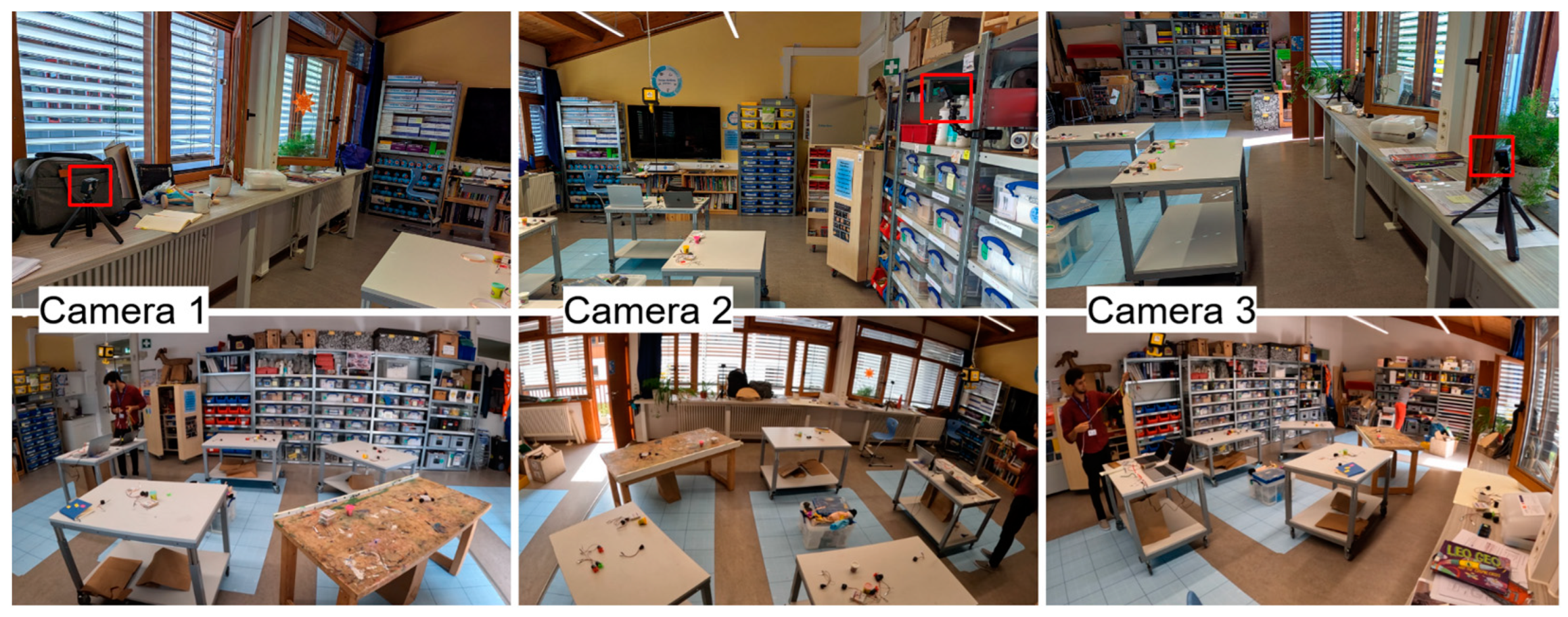
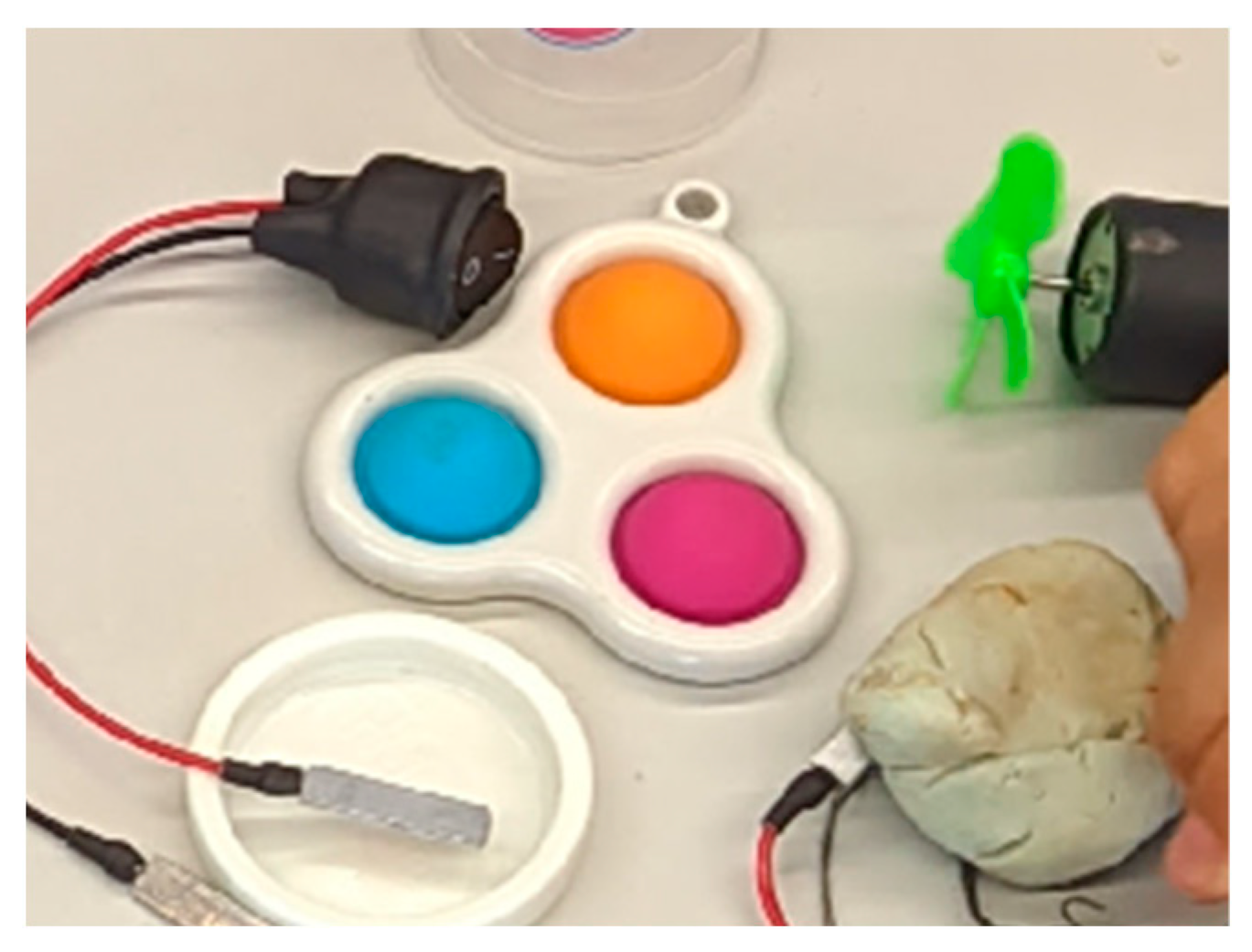
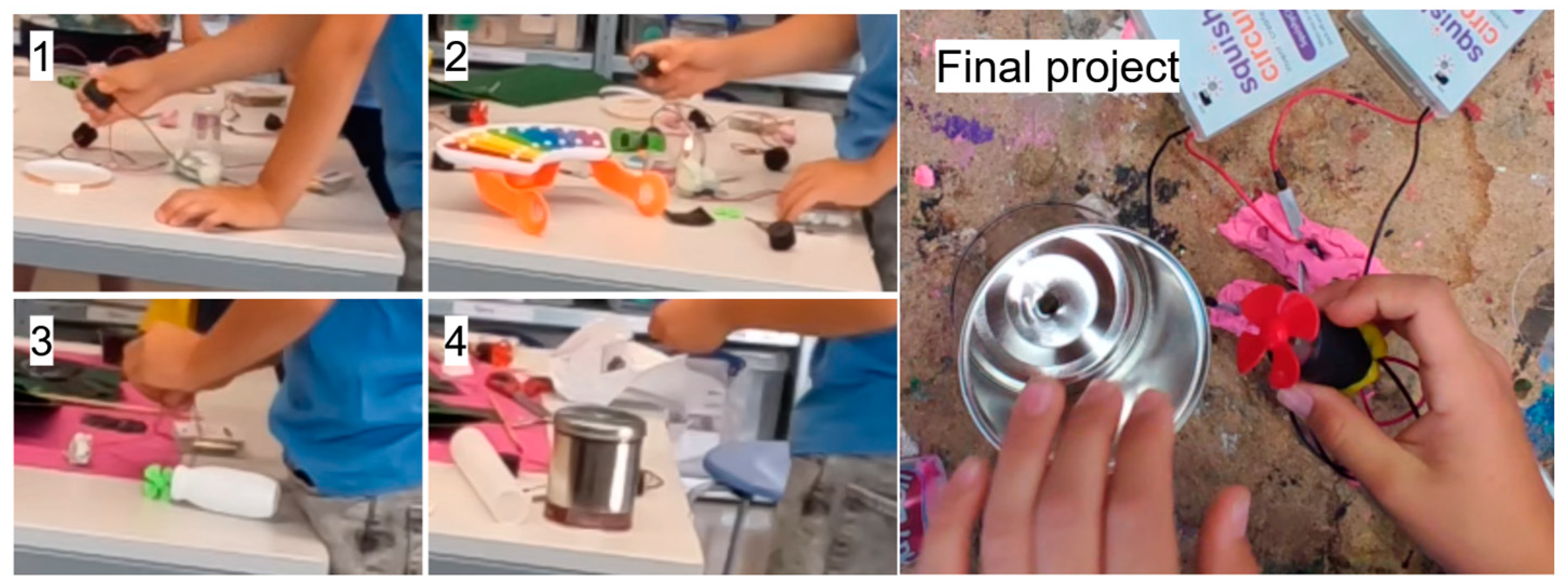
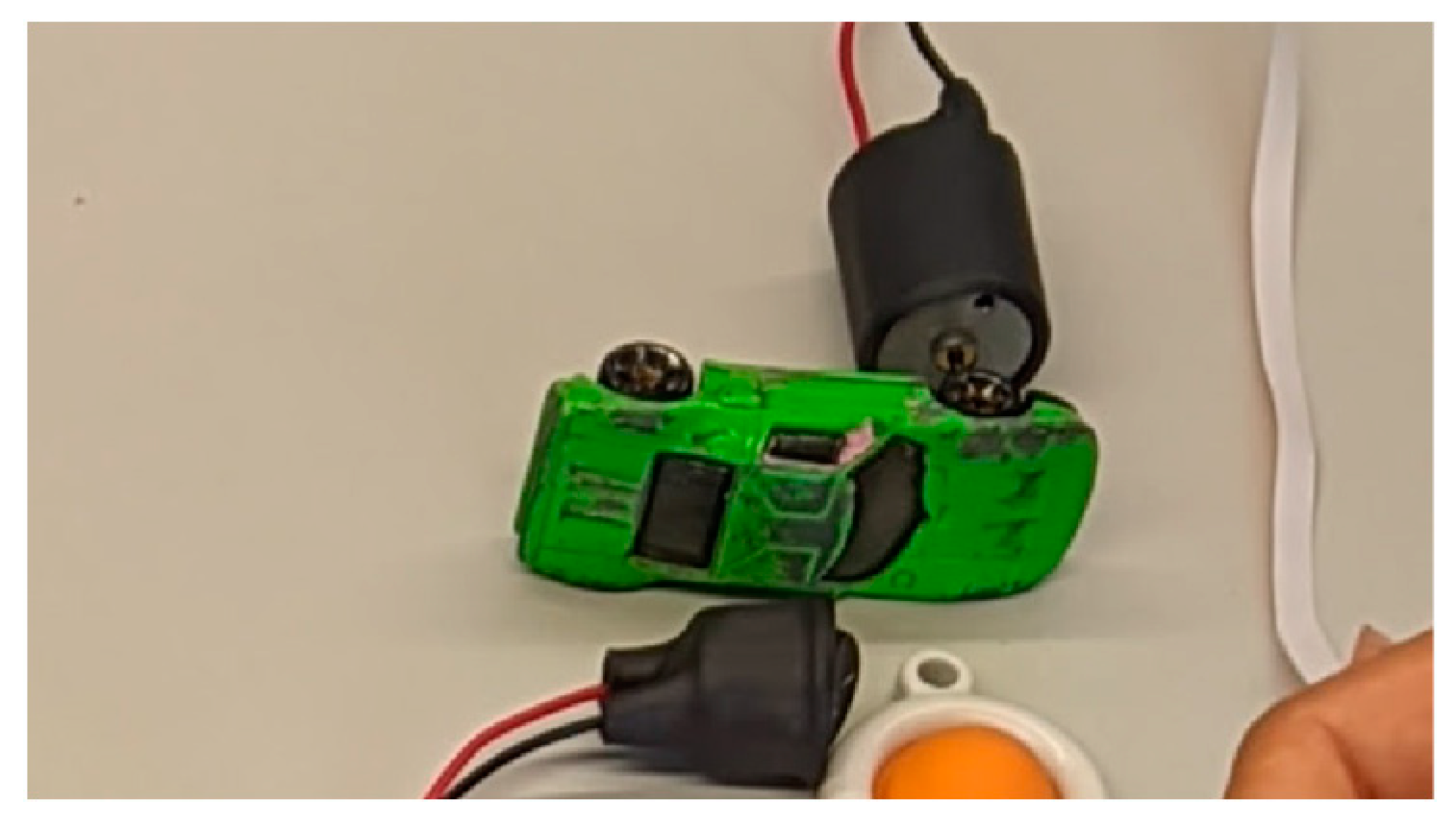
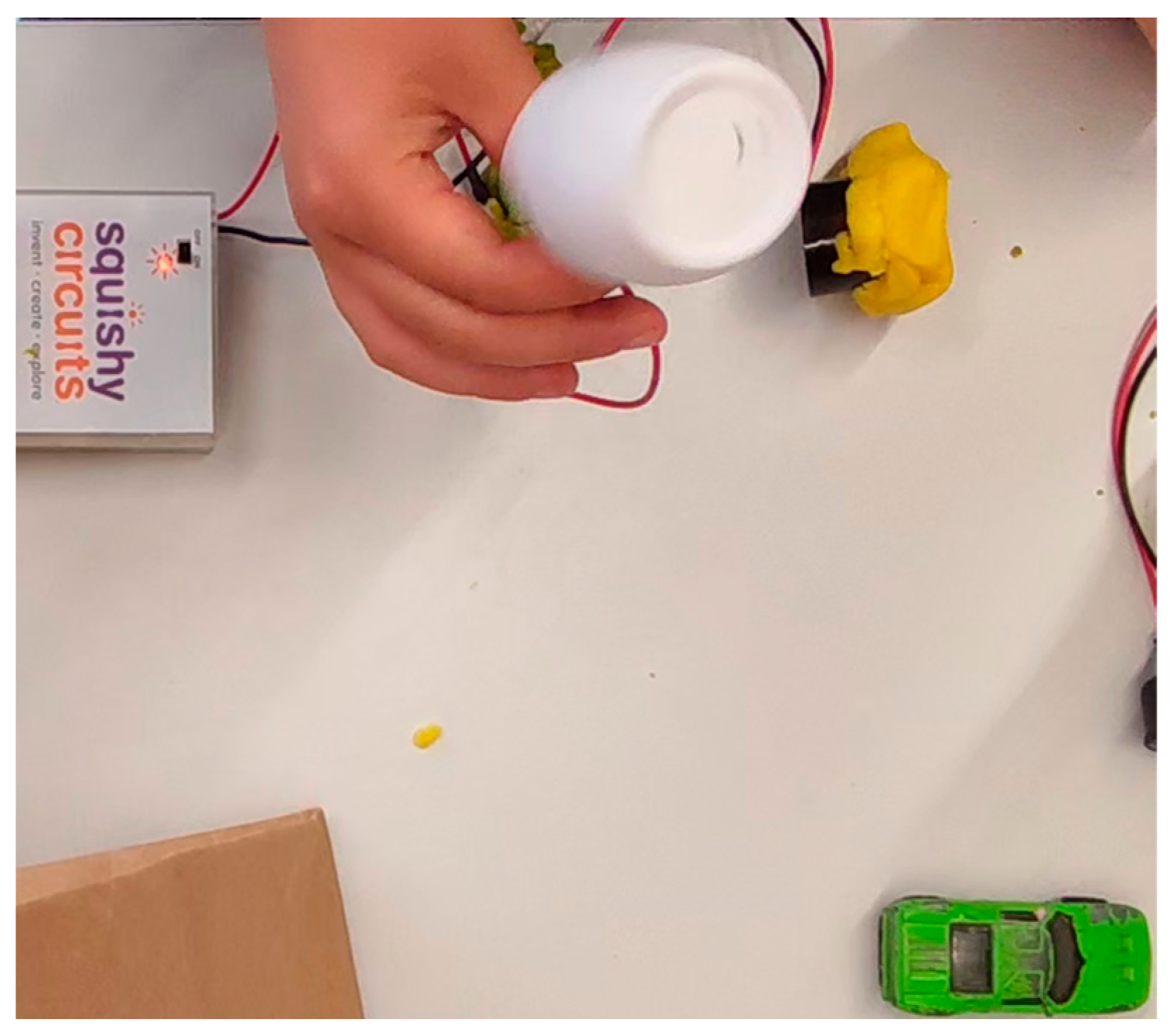
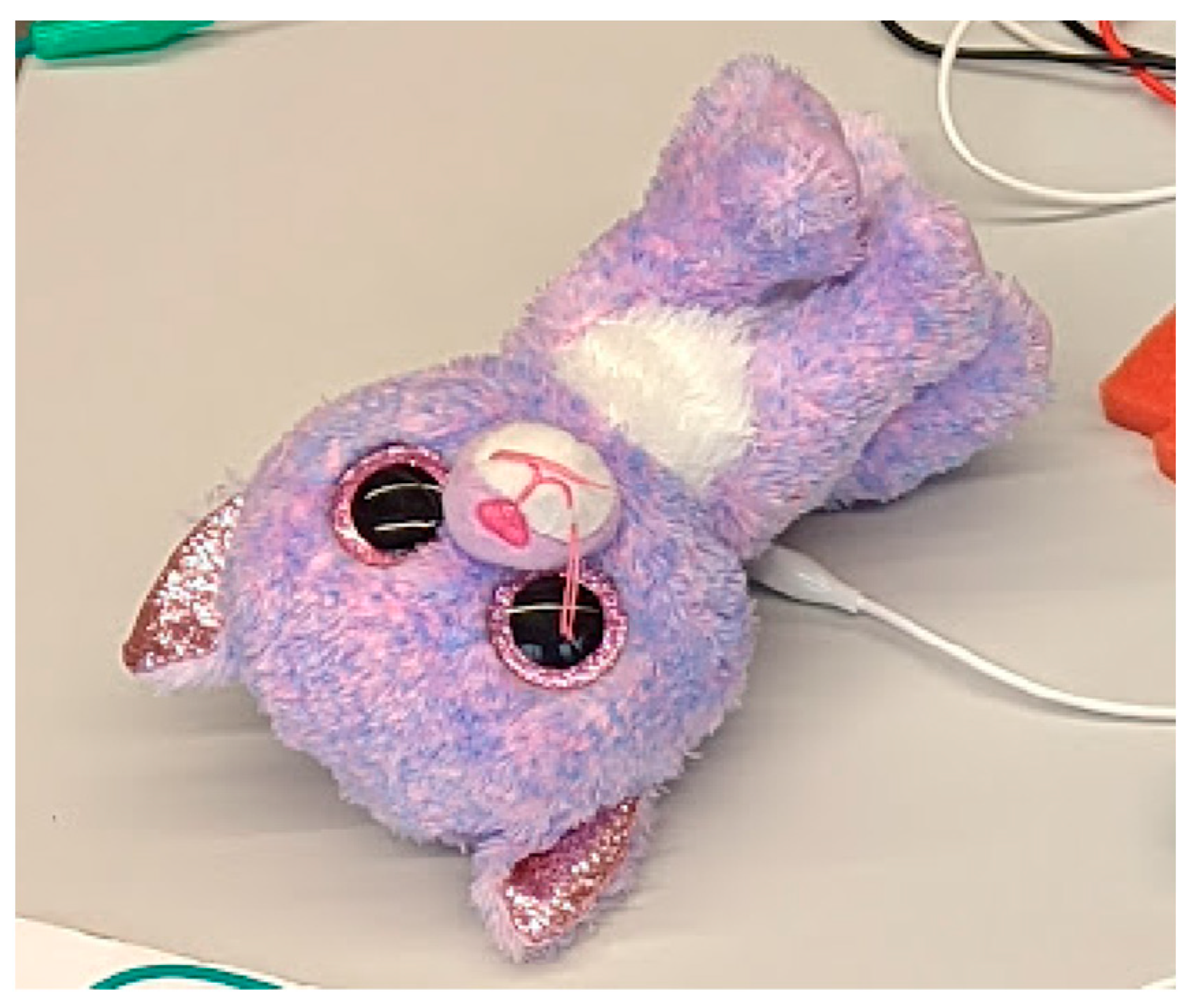
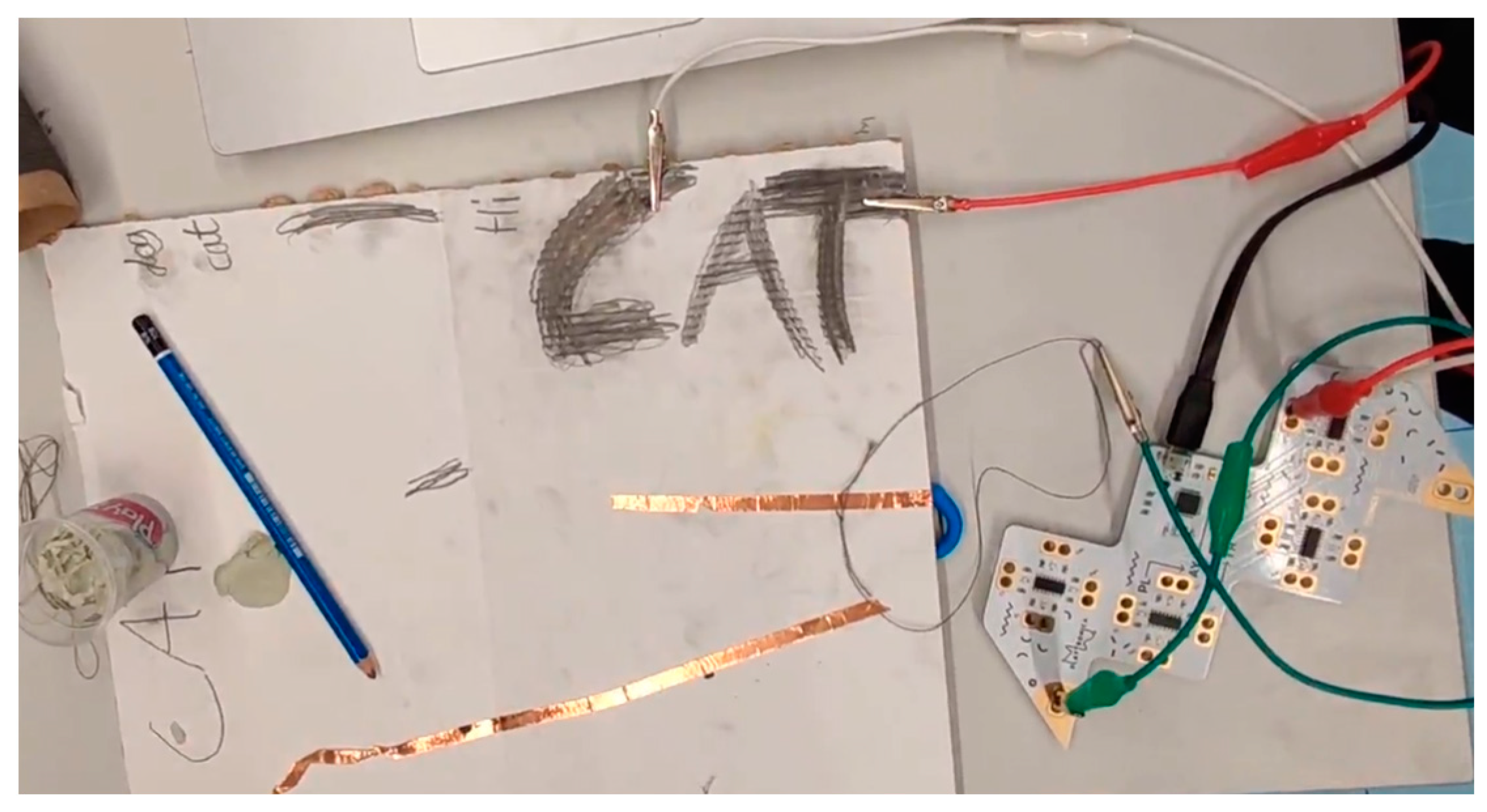
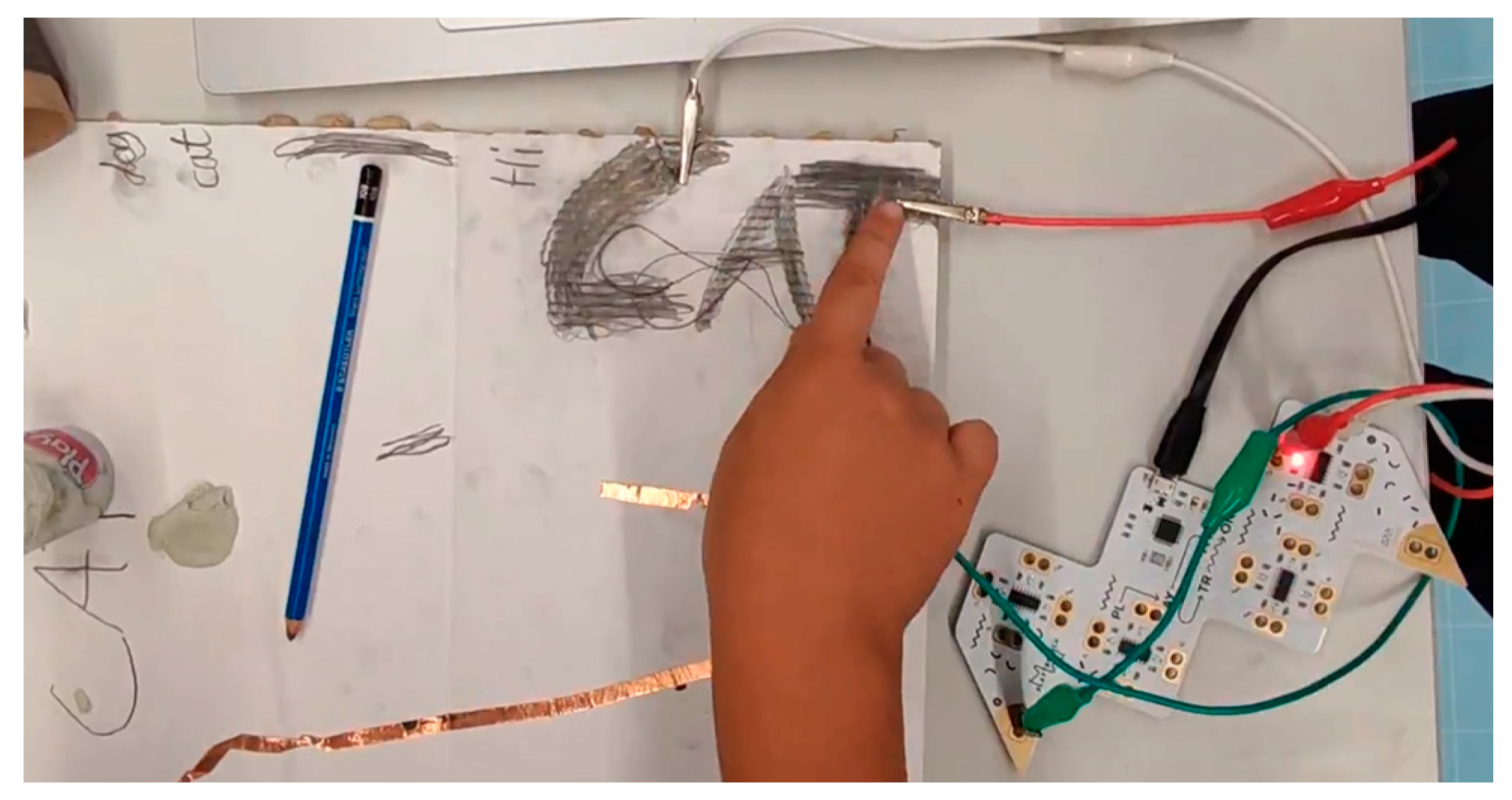
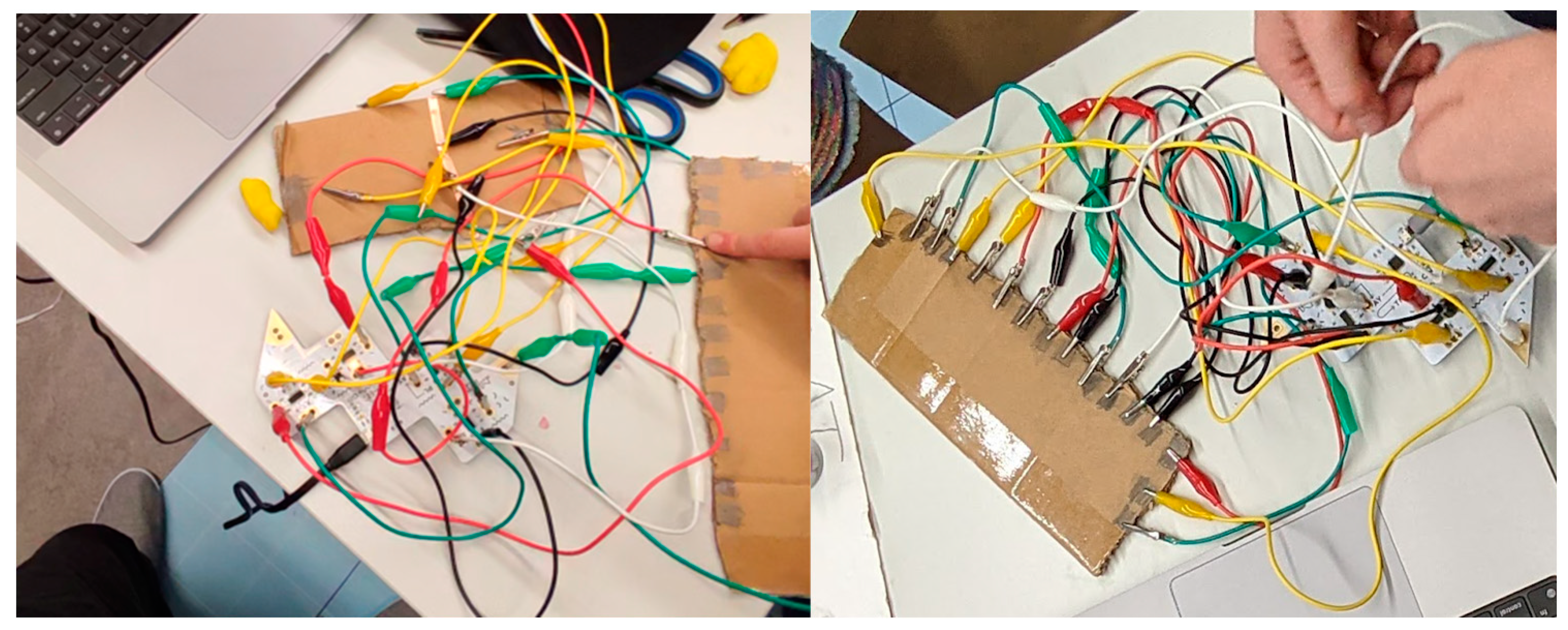
| Sound-Making Kit | Number of Participants Who Used Kit in Group 1 | Number of Participants Who Used Kit during Group 2 |
|---|---|---|
Playtron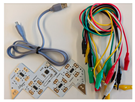 | n = 2 | n = 2 |
Squishy Circuits | n = 8 | n = 9 |
| NGSS Standard | Definition |
|---|---|
| MS-ETS1-1 Engineering Design | Define the problem’s criteria and constraints precisely, considering scientific principles and potential impacts on people and the environment to limit possible solutions. |
| ETS1.A Defining and Delimiting Engineering Problems | Clear criteria and constraints in a design task increase the likelihood of a successful solution. This includes considering scientific principles and relevant knowledge that limit possible solutions. |
| ETS1.B Developing Possible Solutions | In order to enhance a solution, it is necessary to test it and make modifications based on the test results. |
| ETS1.C Optimizing the Design Solution | Iteratively testing solutions and modifying based on test results leads to refinement. |
| MS-ETS 1-1 Asking Questions and Defining Problems | Create a design problem that requires developing an object, tool, process, or system, considering multiple criteria, constraints, and scientific knowledge that may limit solutions. |
| MS-PS3-3 Constructing Explanations and Designing Solutions | Building on experiences from K-5, the process of constructing explanations and designing solutions in grades 6–8 advances by incorporating multiple sources of evidence that align with scientific ideas, principles, and theories. |
| MS-PS3-4 Planning and carrying out investigations | Advancing from grades K-5, the process of planning and conducting investigations in grades 6–8 includes exploring inquiries with multiple variables to provide evidence supporting explanations or solutions. |
| MS-PS3.C Relationship Between Energy and Forces | Models serve as representations of systems and their interactions, including inputs, processes, and outputs. They also depict the flows of energy and matter within these systems. |
Disclaimer/Publisher’s Note: The statements, opinions and data contained in all publications are solely those of the individual author(s) and contributor(s) and not of MDPI and/or the editor(s). MDPI and/or the editor(s) disclaim responsibility for any injury to people or property resulting from any ideas, methods, instructions or products referred to in the content. |
© 2023 by the authors. Licensee MDPI, Basel, Switzerland. This article is an open access article distributed under the terms and conditions of the Creative Commons Attribution (CC BY) license (https://creativecommons.org/licenses/by/4.0/).
Share and Cite
Hurtado, S.; Leinonen, T.; Keune, A. Personally Meaningful Design: Sound Making to Foster Engineering Practices with Artifacts from Home. Sustainability 2023, 15, 14962. https://doi.org/10.3390/su152014962
Hurtado S, Leinonen T, Keune A. Personally Meaningful Design: Sound Making to Foster Engineering Practices with Artifacts from Home. Sustainability. 2023; 15(20):14962. https://doi.org/10.3390/su152014962
Chicago/Turabian StyleHurtado, Santiago, Teemu Leinonen, and Anna Keune. 2023. "Personally Meaningful Design: Sound Making to Foster Engineering Practices with Artifacts from Home" Sustainability 15, no. 20: 14962. https://doi.org/10.3390/su152014962
APA StyleHurtado, S., Leinonen, T., & Keune, A. (2023). Personally Meaningful Design: Sound Making to Foster Engineering Practices with Artifacts from Home. Sustainability, 15(20), 14962. https://doi.org/10.3390/su152014962







